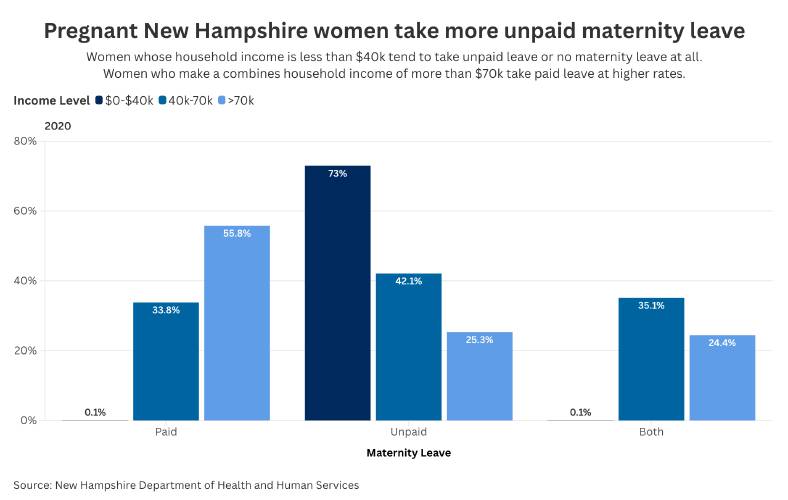Mother’s Day Data: New Hampshire’s declining birth rates impact the workforce and economy

Sruthi Gopalaskrishnan—By
| Published: 05-09-2025 5:47 PM |
As families across New Hampshire celebrate Mother’s Day, data shows that mothers face growing challenges in the state from pressures around maternity leave and childcare to unintended pregnancies.
New Hampshire is experiencing one of the steepest birth rate declines in the nation, a trend driven by a complex mix of socioeconomic factors affecting families across the state, according to experts.
According to the National Vital Statistics Report, New Hampshire had the fifth-lowest fertility rate in the United States in 2023, with just 46.8 births per 1,000 women aged 15 to 44.
Nicole Heller, senior policy analyst at the New Hampshire Fiscal Policy Institute, said that in a state where the birth rate is now lower than the death rate, the impact can start to show on the labor force.
“As people age, as people go out of the labor force and retire, we may not have young people to move into those jobs,” said Heller. “That can become a labor force constraint and an economic constraint.”
Between 2019 and 2023, the state saw approximately 39,525 births and 46,128 deaths, leading to a population decline of about 6,603 people.
Data from the New Hampshire Department of Health and Human Services shows that nearly one-third of all pregnancies in the state in 2020 were unintended.
The women who responded said they either wanted the pregnancy at a later time, did not want it at all or were unsure if they wanted to be pregnant.
Article continues after...
Yesterday's Most Read Articles
 New Hampshire providers brace for Medicaid changes that reach beyond healthcare
New Hampshire providers brace for Medicaid changes that reach beyond healthcare
 New England College expands $10,000-per-year offer to Concord, Bishop Brady graduates
New England College expands $10,000-per-year offer to Concord, Bishop Brady graduates
 Concord school leaders weigh the future of middle school project without state building aid
Concord school leaders weigh the future of middle school project without state building aid
 Truck collision on South Main Street in Concord diverts traffic
Truck collision on South Main Street in Concord diverts traffic
 Warner shot down a housing developer’s bid. New statewide zoning mandates could clear a path for proposals like it.
Warner shot down a housing developer’s bid. New statewide zoning mandates could clear a path for proposals like it.
Among those cases, the majority were younger women.
58% of the women reporting unintended pregnancies were under the age of 25. That marks a sharp increase from 2019, when that figure was just 36.1%.
A growing number of pregnant women in New Hampshire are also opting not to take unpaid maternity leave, according to a recent report from the New Hampshire Fiscal Policy Institute.
State data from 2020 shows that 42.1% of women took only paid maternity leave, while 25.6% took paid and unpaid leave. Meanwhile, 38.7% of women relied solely on unpaid leave.
Heller said that rising childcare costs may be one factor influencing these decisions.
“For women in the labor force who have children, they may have to cut back on hours if they’re not able to access child care,” said Heller. “They may have to leave the labor force or they may have to hold off on things like promotions or pursuing a higher-paying job because they’re balancing the responsibilities that they have with their children, as well as trying to build their careers.”
Sruthi Gopalakrishnan can be reached at sgopalakrishnan@cmonitor.com
12







 Canterbury honors ‘real heroes’ with updated Military Veterans’ Project
Canterbury honors ‘real heroes’ with updated Military Veterans’ Project Look, up in the sky! It’s… an Airstream trailer?
Look, up in the sky! It’s… an Airstream trailer? Around Concord: Over The Moon Farmstead brings mead, beer, pizza and music to Pittsfield
Around Concord: Over The Moon Farmstead brings mead, beer, pizza and music to Pittsfield Around Concord: The Balshaws bring a rustic revival to the Canterbury Country Store
Around Concord: The Balshaws bring a rustic revival to the Canterbury Country Store
